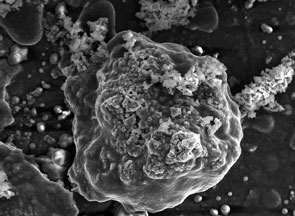| Posted: August 13, 2008 |
NanoArt for Kids program opens the window to nanoscience for K-12 students |
|
(Nanowerk News) The NanoArt K12 program has been launched by Cris Orfescu, artist and scientist from NanoArt21.org in collaboration with Judith Light Feather, artist and founder of The Nanotechnology Group Inc., which provides support to group members for the facilitation and development of innovative Nanoscale Science education globally.
|
|
The purpose of this worldwide program is to stimulate creativity and expand the visionary imaginations of our children through innovative education activities to promote a new paradigm unifying the art-science-technology intersections at the nanoscale. Size matters in all scales of science and textbook publishers have not included the nanoscale of science in their subject matter for K-12 students. Universities are now offering teachers workshops in various areas of the country to explain nano science to high school students in hopes that they will introduce new material into their classrooms.
|
|
NanoArt is a new discipline which combines art with science creating paintings and sculptures at molecular and atomic levels. Scientists use chemical or physical processes to explore the surfaces, composition and interaction of elements at the nanoscale, which can now be viewed and manipulated with powerful research tools like scanning electron (SEM) scanning tunneling (STM) and atomic force microscopes (AFM). These scientific images are then captured and further processed, using different digital techniques. Since these tools are too expensive for primary grade classrooms we will be providing weblinks to sites that the children, parents and teachers can explore.
|
|
Nano means ‘dwarf' and a nanometer is 1 billionth of a meter which is too small to see with the human eye. This unique introduction to the K-12 students showcasing the beauty of nature at this tiny scale of science is designed to stimulate their imagination and curiosity strengthening the desire to learn more science, technology and engineering (STEM) courses as they move through the primary grades and enter high school.
|
|
Art is the perfect media for this first introduction as the visual scans naturally challenge the child to recognize patterns in the shapes they are familiar with in their everyday reality. You will soon discover when viewing the scans provided that many familiar shapes will appear within the scans that can be further developed through drawings, paintings and sculptures, which can be submitted for the NanoArt K12 online exhibition. All compositions will be grouped online by age/grade level for the viewers.
|
  |
| Left: Nanoflower scan for art; Right: ‘Nano Wisdom' oil pastel painting
|
|
In preparing for this launch Light Feather developed an oil pastel painting from the nanoflower scan (shown above) that would serve as an example of an image that was reflected in the patterns. "I could have created a flower, a bear, or a monkey as the example, but my imagination saw the owl as the predominant shape that resonated with my mind. I have titled it "Nano Wisdom" as the energy of the owl has always been noted in Native American cultures to honor wisdom and 'wisdom keepers.' In moving forward to present this science to our young children and the research that will result in new technology we will need this wisdom," she said.
|
|
"It is our intention that the NanoArt for Kids will open the door for teachers to explore the outsource materials being created and include some of the visual elements and experiential online labs in their classrooms in the future."
|
|
You can download the PDF file of the recommended modules for exploration and the Form for submitting your child's artwork at http://www.nanonews.tv/documents/44.html .
|
|
Send your questions to [email protected] or [email protected]
|


